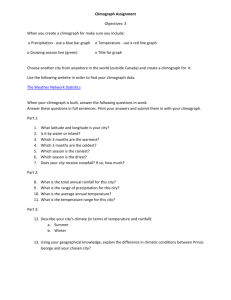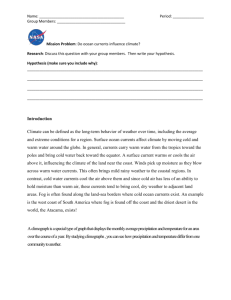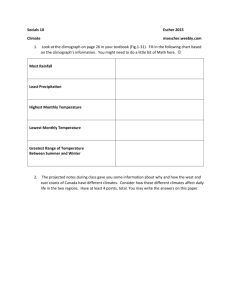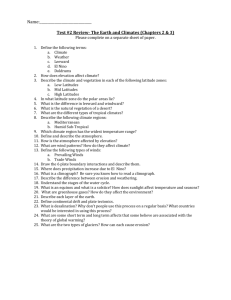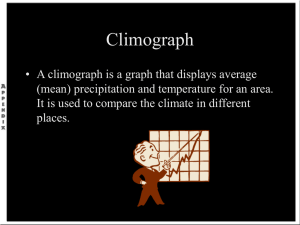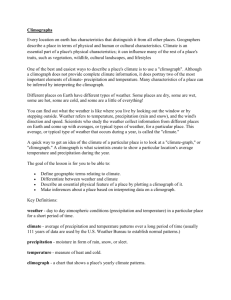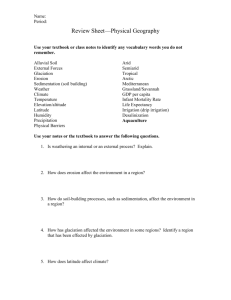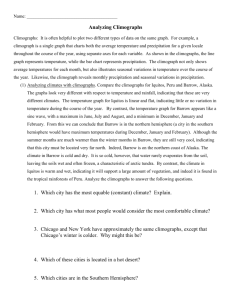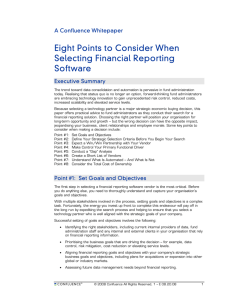Assignment 2
advertisement
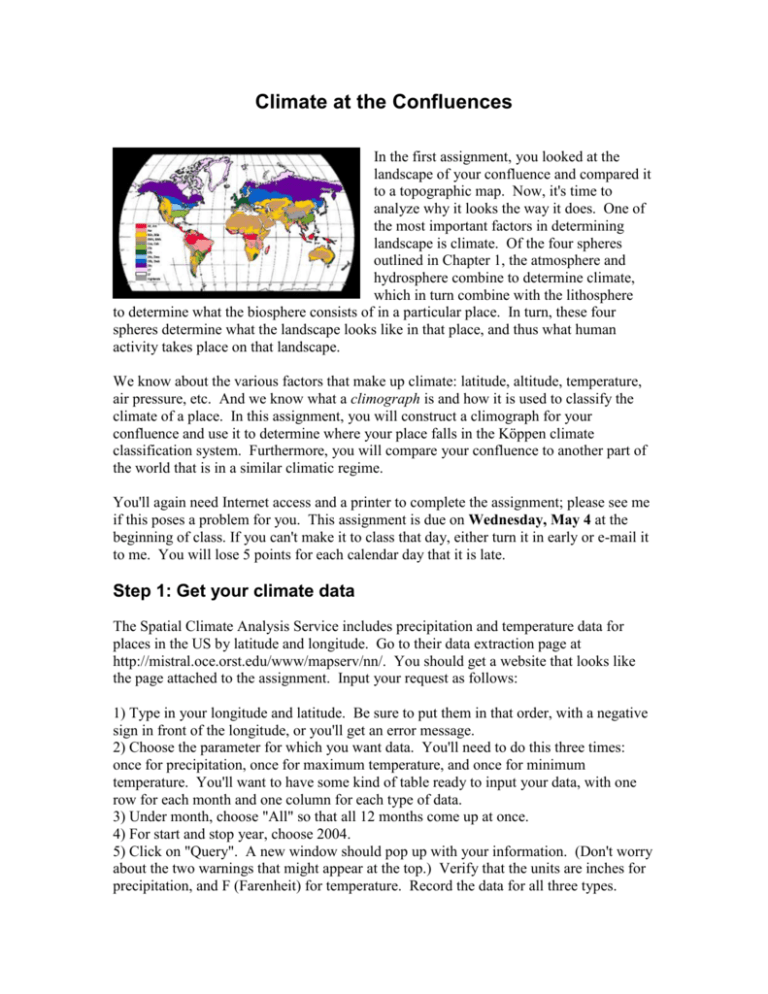
Climate at the Confluences In the first assignment, you looked at the landscape of your confluence and compared it to a topographic map. Now, it's time to analyze why it looks the way it does. One of the most important factors in determining landscape is climate. Of the four spheres outlined in Chapter 1, the atmosphere and hydrosphere combine to determine climate, which in turn combine with the lithosphere to determine what the biosphere consists of in a particular place. In turn, these four spheres determine what the landscape looks like in that place, and thus what human activity takes place on that landscape. We know about the various factors that make up climate: latitude, altitude, temperature, air pressure, etc. And we know what a climograph is and how it is used to classify the climate of a place. In this assignment, you will construct a climograph for your confluence and use it to determine where your place falls in the Köppen climate classification system. Furthermore, you will compare your confluence to another part of the world that is in a similar climatic regime. You'll again need Internet access and a printer to complete the assignment; please see me if this poses a problem for you. This assignment is due on Wednesday, May 4 at the beginning of class. If you can't make it to class that day, either turn it in early or e-mail it to me. You will lose 5 points for each calendar day that it is late. Step 1: Get your climate data The Spatial Climate Analysis Service includes precipitation and temperature data for places in the US by latitude and longitude. Go to their data extraction page at http://mistral.oce.orst.edu/www/mapserv/nn/. You should get a website that looks like the page attached to the assignment. Input your request as follows: 1) Type in your longitude and latitude. Be sure to put them in that order, with a negative sign in front of the longitude, or you'll get an error message. 2) Choose the parameter for which you want data. You'll need to do this three times: once for precipitation, once for maximum temperature, and once for minimum temperature. You'll want to have some kind of table ready to input your data, with one row for each month and one column for each type of data. 3) Under month, choose "All" so that all 12 months come up at once. 4) For start and stop year, choose 2004. 5) Click on "Query". A new window should pop up with your information. (Don't worry about the two warnings that might appear at the top.) Verify that the units are inches for precipitation, and F (Farenheit) for temperature. Record the data for all three types. Step 2: Create a climograph There is a blank climograph attached to this assignment. Fill in the data you've collected in two stages: 1) The left side of the graph indicates precipitation. For each month, draw a short horizontal line that indicates the amount of precipitation received in that month. Fill in the area below that short line to make a bar graph, one bar for each month. Note on the side what the total annual precipitation is. 2) The right side of the graph indicates temperature. Now, your temperatures are minimums and maximums, not means, but it's possible to estimate the mean based on the data you do have. Take the average of the minimum and maximum for each month, and plot it on the climograph. (Note: this is not the same as the mean temperature, but it's close enough for our purposes.) Step 3: Classify your climate In order to determine which climate classification your confluence falls under, you'll need to either refer to Table 8-3 in your text. First, determine which of the five main categories your climograph falls under -- tropical, dry, mild midlatitude, severe midlatitude, or polar/highland -- based on the temperatures you've calculated and plotted. (If you think you might have a desert or steppe, you'll have to look at precipitation first.) This determines the first letter of your classification. Next, look at the bar graph of precipitation, and then at the descriptions in Table 8-3 in your text of the second letter. Is your precipitation year-round or seasonal, high or low? Decide what the second letter of your classification is. For polar or tropical climates, you're done. For midlatitude or dry climates, there's one more letter to go. Look back at the temperature graph and see which letter's description fits what you see in terms of high and low temperatures. For desert or steppe, you'll have to calculate the average annual temperature for the last letter. Once you've determined what your climate classification is, look at the climograph in the book that corresponds to yours, and make sure both the bar graphs and temperature graphs look similar. Step 4: Compare your climate The world map in Figure 8-5 includes large areas that fall under each particular classification. Find a place on another continent that has the same climatic classification as your confluence, preferably not the example given in the book. Where is this place? Use an atlas or online map to find a city in this area. Compare and contrast that city to your confluence, including the following: Latitude Insolation received (look at Figure 4-22 in the text) Altitude Continental vs. maritime influence Proximity to topography that might affect climate Are any of these characteristics significantly different from your confluence? If so, why do you think their climates are so similar? Step 5: What do I do now? You will turn in three parts for this assignment: the data that you collected (handwritten tables are okay), the climograph that you constructed, and 1-2 written pages. You'll describe the data, explain what classification your confluence falls under and how you came to that conclusion, and discuss the comparisons between your confluence and the place from Step 4. The same rules about format apply as in the previous assignment. This assignment is worth 200 points. You will be graded as follows: Climograph construction 50 points Climate classification 50 points Justifying your classification 50 points Comparing your confluence to another place 50 points
